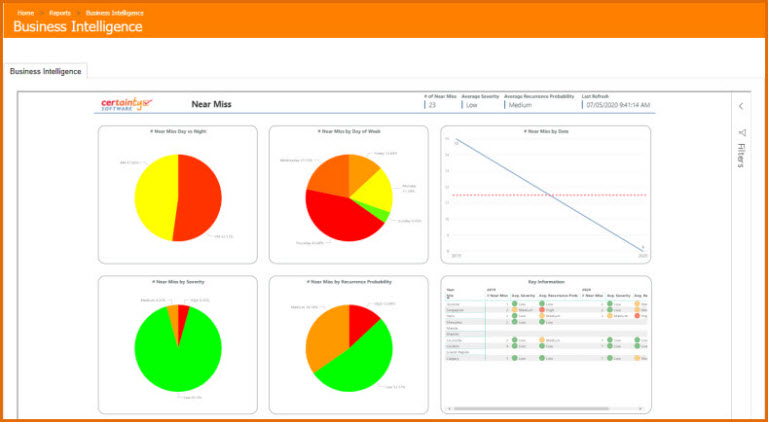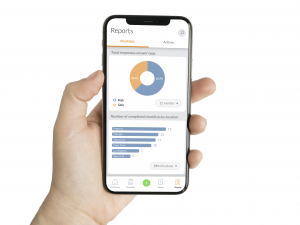No workplace is perfectly safe. Despite best efforts, incidents happen — machines may experience sudden failures or staff may unintentionally expose themselves or others to risk. Consider recent data from the U.S. Bureau of Labor Statistics (BLS), which found that private industry employers reported 2.7 million nonfatal workplace injuries and illnesses in 2020. While the good news is that this number is down 5.7 percent from 2019 totals, it doesn’t tell the whole story: What the data doesn’t cover is the host of “near miss” incidents that occur on-site but thankfully don’t lead to injury or death. To help address these potential hazards, companies need to implement robust incident reporting tools as part of larger safety management programs. But what exactly is incident reporting? Why does it matter? How does it work, and how do companies implement effective plans? Here’s what you need to know.

What is Incident Reporting?
Incident reporting is the process of recording the details of an incident and reporting it to management to help inform safety management programs at scale. Incident reports can occur after workplace accidents or injuries occur, and are also used to report
“near miss” accidents that didn’t result in equipment damages or harm but speak to the need for improved processes.
What is the Purpose of Incident Reporting Programs?
The purpose of incident reporting programs is to reduce the risk of worker injury or fatalities while also streamlining operations. Consider a near miss that involves a staff member nearly being injured while working on a machine thanks to the positioning of specific tools along a production line. If this incident isn’t reported, the issue will continue to occur, in turn costing companies time and money as staff attempt to work around the problem. Even more worrisome? Eventually, the near miss will not miss and the results could be significant.
Key Benefits of Incident Reporting
Incident reporting offers several benefits for organizations, including:
Immediate response
In-situ incident reporting systems help drive immediate responses from management and supervisors. While waiting until the end of the shift is often the preference of staff members, it’s worth competing reports ASAP so safety teams have the data they need to identify root causes and take corrective action.
Clear communication
Incidents that are confined to specific areas of the production floor or warehouse will disproportionally affect some staff more than others. The result? Employees who don’t regularly work in these areas may be at greater risk of injury since they aren’t familiar with existing issues. Incident reports ensure that adverse events are quickly and accurately communicated across the organization.
Ongoing improvement
Incident reports both identify specific areas that require remediation and help companies pinpoint trends in operations that suggest the need for a more robust safety response, in turn driving the creation of preventative measures that better protect staff without negatively impacting production.
How are Incident Reports Used?
Incident reports are used to inform larger health and safety management processes. For example, in-depth safety issue evaluations might suggest the need for the replacement of key machinery within the next 2-3 years, but incident reporting could accelerate this timeline if near-misses and minor accidents involving the machinery continue to occur.
Reports are also used as part of the safety auditing process. As expectations around safe workplaces evolve, companies must be able to demonstrate that they have taken all steps possible to make production lines and factory floors as safe as possible, in turn reducing their risk of non-compliance with OSHA and other safety standards.
Achieving this goal means keeping detailed records of all safety-related data. This includes the disbursement and use of proper personal protective equipment (PPE), regular safety meetings and training for staff, and complete incident reporting that demonstrates companies have been paying attention to incidents and taking steps to reduce total risk.
Why is Incident Reporting Essential?
Incident reporting is essential to ensure that key issues are effectively communicated and addressed. As a result, it’s important for businesses to create clear incident reporting processes capable of capturing key data related to any potentially dangerous interactions.
These policies and processes are critical because, in many instances, employees may not see near-misses or avoided accidents as necessary to report. And while it’s important to balance the need for reporting against the need for work — if a staff member accidentally trips on a flat surface, it’s probably not necessary to create a report — companies must define the circumstances under which reporting is mandatory. For example, if multiple staff members trip over the same area in your warehouse because of buckled concrete or an unexpected step up or down, it’s worth creating an incident report and directly addressing the problem before someone is seriously hurt.

30+ Audit and inspection checklists free for download.
When Should an Incident Report be Completed?
An incident report should be completed in various situations to ensure proper documentation and analysis. Here are the circumstances that warrant the completion of an incident report:
- Serious Incidents
- Medical Incidents
- Near Miss Incidents
- No Harm Incidents
Now, let’s take a deeper look into each specific circumstance that would require you to complete an incident report.
Serious Incidents
Incident reports must be completed for any serious incidents that occur within an organization. These incidents encompass situations that result in injury or death, require immediate medical attention, or cause significant damage. Examples of serious incidents include slips, trips, or falls, as well as environmental or machinery hazards that necessitate work stoppages and emergency responses. By documenting these events, organizations can investigate the causes, implement corrective actions, and prevent similar incidents in the future.
Medical Incidents
Incident reports are necessary for medical incidents that take place either due to pre-existing employee healthcare issues related to medical devices or as a consequence of unsafe workplaces leading to stress reactions or panic attacks. It is crucial to document these incidents to understand the underlying factors contributing to employee health concerns and to address any potential hazards or risks in the work environment.
Near Miss Incidents
Near miss incidents, often referred to as close calls, require the completion of incident reports. These incidents involve situations where injuries or property damages were narrowly avoided, but there remains a significant risk for potential harm in the future. For instance, near miss vehicle accidents fall into this category. Reporting near misses allows organizations to analyze the root causes, identify potential weaknesses in safety protocols, and take proactive measures to prevent future incidents.
No Harm Incidents
No harm incidents are similar to near misses but on a broader scale. They encompass incidents that indicate larger safety trends within an organization. While no immediate harm or damage may have occurred, these incidents highlight potential risks that, if left unaddressed, could lead to injuries or damages in the future. Reporting no harm incidents enables organizations to track and evaluate safety trends, identify systemic issues, and implement corrective actions to mitigate risks effectively.
What Does a Solid Incident Management Framework Look Like?
To ensure effective workplace incident reporting, companies must create reliable and repeatable frameworks that make it clear what employees are expected to report, how they should report it, and when reports should be completed.
First, organizations need to create clear incident report templates that ask for specific information such as the time of the incident, date, location, individuals or machinery involved, and a brief description of the incident. Next is a remediation plan that sees these reports used to develop a response that minimizes risk and in turn reduces the total number of incidents.
As part of a larger safety management plan, incident reporting ties into both safety inspections and safety observation reports — armed with detailed incident reports, safety auditors and inspectors can target high-risk areas and make changes directly to address key concerns.

30+ Audit and inspection checklists free for download.
It’s also worth considering the implementation of robust safety software solutions capable of streamlining and centralizing all safety management functions including audits, evaluations, incident reports, and actions taken.
Incident Reports as Part of the Larger Safety Program Picture
Safety management programs are designed to reduce the risk of workplace accidents that could derail production and possibly injure employees. Incident reporting is a key component of effective safety and risk management programs, serving as a way for employees to identify hazards and for companies to take action before more serious incidents occur.
Best bet? If you don’t have a worksite incident reporting program in place, start building one ASAP. If your program works but is bogged down by disconnects with your larger safety structure, leverage connective tools and technologies to ensure you have comprehensive coverage of potential workplace risks.
Ready to improve your incident reporting and streamline safety management? Start with Certainty.
You may also be interested in:
OSHA 300 – Log of Work-Related Injuries & Illnesses
OSHA 301 – Injuries & Illnesses Incident Report Checklist
Case Study: How Huntsman Corporation Improved Their Incident Reporting




